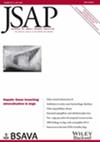Prevalence of respiratory signs in dogs with chronic gastroenteropathy in a referral population in the United Kingdom: 42 cases (2020)
Abstract
Objectives
To determine the prevalence of respiratory signs in a referral population of dogs with chronic gastroenteropathy in the United Kingdom, and to describe the epidemiology and clinical presentation of the affected dogs.
Materials and Methods
Retrospective review of canine patients diagnosed with chronic gastroenteropathy in a referral centre in the United Kingdom. Data included signalment, gastrointestinal and respiratory signs, blood analysis results and, where present, diagnostic imaging techniques, endoscopy, videofluoroscopic swallow study, bronchoalveolar lavage results and treatment response. To be included, a follow-up of a minimum of 3 months was required. Cases were excluded if there was no minimum diagnostic dataset, the aetiology of the respiratory signs was other than gastrointestinal disease or a non-gastrointestinal systemic disease was the cause of the gastrointestinal signs.
Results
One hundred and forty-eight dogs were included and 42 (28.4%) had concurrent respiratory signs. Gagging (69%) and vomiting (52.4%) were the most common gastrointestinal signs, while coughing (50%), tachypnoea (33.3%) and reverse sneezing (30.9%) were the most common respiratory signs. Abdominal ultrasound was performed in 31 (73.8%) while CT scan was the most common modality for thoracic (62.5%) and head (21.9%) imaging. Endoscopic procedures included gastrointestinal (54.8%), bronchoscopy (19%) and rhinoscopy (23.8%). Dietary modification was the most common treatment (66.67%). Eleven dogs (26.2%) had a relapse of the respiratory signs during the follow-up period, of which, nine (81.8%) had a concurrent relapse of the gastrointestinal signs.
Clinical Significance
Concurrent respiratory signs in dogs with chronic gastroenteropathy are frequent. A clinical improvement of these respiratory signs might be achieved during the therapeutic management of gastrointestinal disorders.

 求助内容:
求助内容: 应助结果提醒方式:
应助结果提醒方式:


